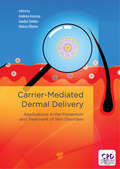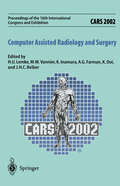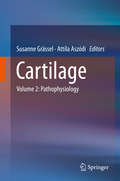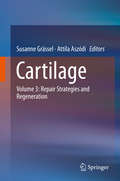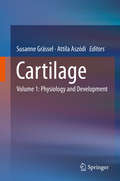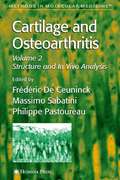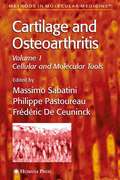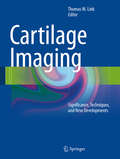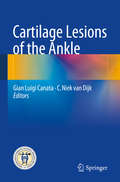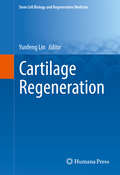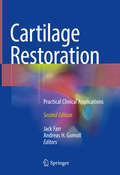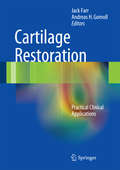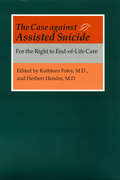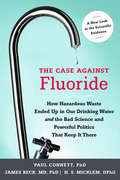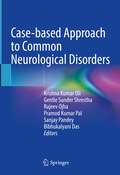- Table View
- List View
Carrier-Mediated Dermal Delivery: Applications in the Prevention and Treatment of Skin Disorders
by Andreia Ascenso Sandra Simões Helena RibeiroThis book presents new approaches for skin aging and photocarcinogenesis and topical formulations based on nanocarrier systems for skin disorders. It discusses cosmeceuticals, laser, photodynamic therapy, and melatonin-based treatments as important strategies for photoaging management. Photodynamic therapy and melatonin can be used in the photocarcinogenesis context, too. Therefore, the inclusion of this strong antioxidant in sunscreen products could be a promising approach. The book discusses topical formulations, including emulsions (conventional formulations and emulsions stabilized by solid particles), nail films, and nanocarriers used for the delivery of actives in various skin and nail diseases such as acne, psoriasis, atopic dermatitis, fungal diseases, leishmaniasis, and skin cancer. Finally, several nanocarriers are introduced, such as lipid vesicles (ranging from the first-generation conventional liposomes to the more recent deformable vesicles), liquid crystalline nanodispersions, gelatin, and solid lipid nanoparticles. Their composition, formulation, characterization, and topical applications are also discussed. Although this is a broad topic, the most important (nano)pharmaceutical formulations are presented in the book.
Carrying The Single Dad's Baby: Carrying The Single Dad's Baby The Family They've Longed-for The Nurse's Pregnancy Miracle (Mills And Boon Medical Ser.)
by Kate HardyOne night of comfort… One unexpected miracle!
Carrying The Surgeon's Baby: Island Doctor To Royal Bride? Heart Surgeon, Prince... Husband! Carrying The Surgeon's Baby (Mills And Boon Medical Ser.)
by Amy RuttanWhat happened in Vegas… Has life-changing consequences!
CARS 2002 Computer Assisted Radiology and Surgery: Proceedings of the 16th International Congress and Exhibition Paris, June 26–29,2002
by H. U. Lemke M. W. Vannier K. Inamura A. G. Farman K. Doi J. H. C. ReiberProgess in specific computer-assisted techniques (digital imaging , computer-aided diagnosis, image-guided surgery, MEMS, etc.) combined with computer-assisted integration tools offers a valuable complement to or replacement for existing procedures in healthcare. Physicians are now employing PACS and telemedicine systems as enabling infrastructures to improve quality of and access to healthcare. Tools based on CAD and CAS facilitate completely new paths in patient care. To ensure that CARS tools benefit the patient, collaboration between various disciplines, specifically radiology, surgery, engineering, informatics, and healthcare management, is a critical factor. A multidisciplinary congress like CARS is a step in the desired direction of knowledge sharing and crossover education. It provides the necessary cooperative framework for advancing the development and application of modern computer-assisted technologies in healthcare.
Cartilage: Volume 2: Pathophysiology
by Susanne Grässel Attila AszódiIn three Volumes this mini book series presents current knowledge and new perspectives on cartilage as a specialized yet versatile tissue. This second volume is dedicated to basic pathologies of the two most common osteoarticular diseases affecting large segments of the Western population, osteoarthritis and chondrodysplasias. This book addresses Professors, researchers and PhD students who are interested in musculoskeletal and cartilage biology and pathobiology.
Cartilage: Volume 3: Repair Strategies and Regeneration
by Susanne Grässel Attila AszódiIn three Volumes this mini book series presents current knowledge and new perspectives on cartilage as a specialized yet versatile tissue. This third volume provides insight into current and future treatment strategies for repair of cartilage lesions. This book addresses Professors, researchers and PhD students who are interested in musculoskeletal and cartilage pathobiology and tissue-engineering.
Cartilage: Volume 1: Physiology and Development
by Susanne Grässel Attila AszódiIn three Volumes this mini book series presents current knowledge and new perspectives on cartilage as a specialized yet versatile tissue. This first volume provides a comprehensive overview on the basic composition and development of cartilaginous tissues followed by the description of the major signaling pathways which regulate cartilage morphogenesis and function.This book addresses Professors, researchers and PhD students who are interested in musculoskeletal and cartilage biology.
Cartilage and Osteoarthritis: Structure And In Vivo Analysis (Methods in Molecular Medicine #101)
by Frédéric De Ceuninck, Massimo Sabatini and Philippe PastoureauAn indispensable collection of updated classical and emerging techniques that promise to add critical knowledge to our understanding of cartilage metabolism in health and disease. Volume 1: Cellular and Molecular Tools describes proven molecular and cellular techniques for the in vitro study of normal and osteoarthritic cartilage through biochemical, biomolecular, immunological, and physical approaches, with emphasis on the genetic manipulation of cells. Volume 2: Structure and In Vivo Analysis, offers cutting-edge procedures for the study-at the tissue level-of turnover, structure, and functioning of normal and diseased articular cartilage by invasive and noninvasive means. Comprehensive and up-to-date, the two volumes of Cartilage and Osteoarthritis provide researchers and bench scientists with readily reproducible protocols for new experiments to understand-from the cellular to the animal level-the pathophysiology of cartilage and to discover molecular targets for pharmacological intervention.
Cartilage and Osteoarthritis: Cellular And Molecular Tools (Methods in Molecular Medicine #100)
by Massimo Sabatini, Philippe Pastoureau and Frédéric CeuninckOsteoarthritis (OA), the most common form of arthritis, is generally characterized by a slowly progressive degeneration of articular cartilage, particularly in the weight-bearing joints. It has a stronger prevalence in women, and its incidence increases with age. OA is a major and growing health concern in developed countries, owing to steadily increasing life expectancy and the demand for better quality of life. Because of its chronic nature and nonfatal outcome, OA affects the growing population of the elderly over an increasing time span. Moreover, despite its relatively benign character, OA is one of the most disabling diseases; it is responsible for increasing financial and social burdens in terms of medical treatments, forced inactivity, loss of mobility, and dependence. Despite a growing awareness of OA as a medical problem that has yet to reach its maximum impact on society, there is a surprising absence of effective medical treatments beyond pain control and surgery. So far, only symptom-modifying drugs are available, while there remains a major demand for disease-modifying treatments of proven clinical efficacy. This demand will hopefully be met in the future by some of the drugs that have been pressed into development and are now at different stages of clinical investigation. Nevertheless, the current lack of effective treatments reflects a still insufficient knowledge of cartilage with respect to its metabolism, interactions with other joint tissues, and causes and mechanisms (possibly of very different nature) leading to failure of its turnover.
Cartilage Imaging: Significance, Techniques, and New Developments
by Thomas M. M. LinkThis authoritative book provides state-of-the-art practices and new developments in the imaging of cartilage, associated pathologies, and repair procedures. With a main focus on MRI, major advances in cartilage imaging are put into clinical context relevant for radiologists, rheumatologists, and orthopedic surgeons. International experts provide their insights on cartilage pathologies associated with such conditions as osteoarthritis, osteochondral trauma, and cartilage repair. Morphological MRI techniques are outlined, including new sequences and high field imaging. Molecular imaging techniques able to characterize the biochemical composition of the cartilage matrix are discussed, such as T2 relaxation time, T1rho, and dGEMRIC methods.The first book of its kind, Cartilage Imaging: Significance, Techniques, and New Developments encompasses the full scope of knowledge in this rapidly evolving field. Identifying key techniques for characterizing disease processes as well as objectively and quantitatively evaluating the results of therapy, this outstanding resource is of benefit to all physicians interested in assessing cartilage disease and repair.
Cartilage Injury of the Knee: State-of-the-Art Treatment and Controversies
by Aaron J. Krych Leela C. Biant Andreas H. Gomoll João Espregueira-Mendes Alberto Gobbi Norimasa NakamuraCartilage injuries of the knee are common, and diagnosis and treatment options have continued to evolve. This book focuses on current non-operative and surgical treatment strategies for articular cartilage injuries, highlighting the controversies and different approaches from an international perspective. This book includes information on the basic science of cartilage structure and function, expert perspectives on imaging and diagnosing, as well as work-up of athletes and patients presenting with acute or chronic cartilage injury. It also provides an evidence base for current cutting-edge cartilage repair and restoration. Written by leading experts in the field, the book, published in collaboration with ISAKOS and ICRS, is vital reading for orthopaedic and sports medicine surgeons, fellows and residents. It is also of interest to sports trainers, physiotherapists, medical students, postgraduate students, and physical medicine and rehabilitation specialists.
Cartilage Lesions of the Ankle
by Gian Luigi Canata C. Niek DijkThis booklet, published in cooperation with ISAKOS, is a concise, up-to-date guide and reference on the treatment of cartilage lesions of the ankle that will be of practical clinical value for specialists in sports medicine and sports traumatology. Different techniques and the management of various lesions are described step by step, guiding the practitioner through the entire spectrum of care from evaluation of the injury to successful recovery. Chondral and osteochondral lesions of the talus can present as a consequence of repetitive ankle injuries, causing chronic pain, recurrent swelling, and weakness and stiffness of the ankle joint. An accurate early diagnosis is required, using clinical evaluation, imaging techniques and arthroscopy of the ankle. In acute and non-displaced chondral and osteochondral lesions, conservative treatment is the mainstay. Surgery is recommended for unstable and persistent lesions and consists in several techniques focused on regeneration of the cartilage. Returning to play is possible after testing balance and proprioception, strength, range of motion, and agility.
Cartilage Regeneration (Stem Cell Biology and Regenerative Medicine)
by Yunfeng LinThis book focuses on cartilage defects and new mesenchymal stem cell-based treatments for their repair and regeneration. Early chapters provide a review of current etiological findings and repair methods of cartilage defects. The next chapters discuss fundamental concepts and features of MSCs, including their proliferation, differentiation, migration and immunomodulatory effects. The discussion also includes clinical applications of MSCs in cartilage tissues, especially with regards to various animal models, biomaterials and transferring techniques. Cartilage Regeneration focuses on the biology of MSCs and their possible applications in cartilage reconstruction, with the goal of bringing new insights into regenerative medicine. It will be essential reading for researchers and clinicians in stem cells, regenerative medicine, biomedical engineering and orthopedic surgery.
Cartilage Repair and Joint Preservation of the Knee: Expert Consult
by Tom MinasFully updated with recent technologies, current scientific knowledge, and the latest techniques, A Primer in Cartilage Repair and Joint Preservation of the Knee, 2nd Edition, presents the full range of treatment options for a changing, increasingly younger patient population. Using an easy-to-follow, step-by-step approach, Dr. Thomas Minas clearly teaches how to meet the new challenges of cartilage repair by utilizing the latest techniques and technologies, including advances in orthobiologics. Surgical photographs, abundant illustrations, and procedural videos provide detailed visual guidance.
Cartilage Repair Strategies
by Riley J. Williams L. Peterson B. J. ColeThe focus of this book is to create a comprehensive analysis of cartilage injury and repair strategies. Twenty chapters cover proven and emerging procedures and methodologies. Readers will be able to understand the clinical problem, appropriate diagnosis, and repair strategies relevant to first line and secondary cartilage repair procedures.
Cartilage Restoration: Practical Clinical Applications
by Jack Farr Andreas H. GomollNow in a revised and expanded second edition, this practical text utilizes the most current evidence and knowledge of articular cartilage as the basis for clinical interventions for cartilage repair and restoration, combining an overview of clinical research and methodologies with clinical cases to help guide the orthopedic treatment and care of patients presenting with cartilage issues. Carefully updated chapters discuss the state-of-the-art in cartilage anatomy, defects and imaging, current tibiofemoral and patellofemoral surgical options, debridement and marrow stimulation, osteochondral autografts and allografts, osteotomies, cell therapy, and meniscal transplantation. New chapters explore new surgical treatment strategies and revision for failed cartilage repair, case vignettes presenting real-life treatment decisions and outcomes, and rehabilitation protocols following cartilage repair. Written and edited by experts in the field and bringing the most recent literature and research to bear, Cartilage Restoration remains a valuable resource on joint preservation for orthopedic surgeons, residents, and fellows, sports medicine specialists and rheumatologists.
Cartilage Restoration: Practical Clinical Applications
by Jack Farr Andreas H GomollAttempting to bridge the gap between the science and art of cartilage restoration, Cartilage Restoration: Practical Clinical Applications combines an overview of clinical research and methodologies with clinical cases to help guide the orthopedic treatment and care of patients presenting with cartilage issues. With chapters written by internationally-renowned orthopedic surgeons, topics include an overview of current surgical options, debridement and marrow stimulation, autograft plug transfer, allografts, cell therapy, and meniscal issues. Cartilage Restoration is a valuable resource for orthopedic surgeons, residents, and fellows.
Cartilage Surgery and Future Perspectives
by Christian Hendrich Ulrich Nöth Jochen EulertTissue engineering as a technology and as a therapeutic has captured worldwide attention and commitmentbecause it has such potential in the care of humanity. Because we are not as yet able to craft robust three dimensional vascular and ductal structures to support the development of complex parenchymal organs, the initial focus of the field has been on thin tissues that can be nourished by diffusion alone.The best example of this class is cartilage. Thought by some to be a relatively simple tissue in the early days of tissue engineering, deep study of this tissue has shown it to manifest great complexity.Yearsof experimental and clinical effort have begun to untangle the clues that will allow us to reproducibly characterize, gener ate and clinically apply engineered cartilage with positive effects.World wide researchers and clinicians are intently focused on this goal and it has come time to step back and make a good assessment of our progress.
Cartilage Surgery E-Book: An Operative Manual, with Expert Consult
by Mats Brittberg Wayne GersoffCartilage Surgery: An Operative Manual by Mats Brittberg, MD and Wayne Gersoff, MD is your guide to applying the most recent advances in cartilage repair, and performing cutting-edge surgical procedures. An internationally diverse collection of authors offers a global perspective on timely topics such as cartilage biologics. Clinical pearls, operative video clips, and detailed, full-color intraoperative photographs offer step-by-step guidance on essential techniques. You can access the full content and videos online at expertconsult.com.Stay current with the recent advances in cartilage repair including surgical and non-surgical treatments as well as biologic management of cartilage lesions. Get unmatched visual guidance from an unparalleled video collection online that demonstrates how to perform a variety of key techniques. Quickly reference essential topics with a templated, focused format that includes clinical pearls to help you make a confident diagnosis and select the best treatment. Benefit from the knowledge, experience, and global perspective of a diverse collection of leading international authors. Access the book from any computer at ExpertConsult.com, complete with the full text, entire image bank, and video library. Clinical pearls and surgical video allow you to follow the latest in cartilage repair and management
The Cartilaginous Skeleton of the Bronchial Tree (Advances in Anatomy, Embryology and Cell Biology #48/3)
by F. VanpeperstraeteA review of the publications, dealing with the morphology of the cartilages of the tracheo-bronchial tree, shows how scarce they are and how fragmentary the contributions based on research. Isolated parts only of the bronchial tree have been investigated, mostly in single specimens or small series. Anatomical textbooks merely state that the trachea and main bronchi are supported by rings and the more distal branches by irregular, circumferentially placed plates which become smaller towards the periphery, until they disappear in the bronchioli. It is at once obvious that this old-time view is not only superficial, but it leaves one completely ignorant about the site where rings cease and plates begin. No information is available about the arrangement of cartilages around the bifurcations of the main bronchi and contradictory descriptions are given about the cartilaginous architecture of the lobar bronchi. A more searching study reveals that cartilages are hardly mentioned in the huge amount of literature on bronchial anatomy which has accumulated since 1880. It is therefore not exagerated to say that the study of this subject has been grossly neglected.
The Cartographic Atlas of the Brain
by Paulo Abdo KadriNeuroanatomy is considered one of the most complex subjects in the field of anatomy. The reliable literature for students is limited to classical anatomical books, many of them re-editions of publications from the previous century, with black-and-white illustrations or computer-generated images. In this sense, the literature lacks a neuroanatomical atlas depicting the brain's surface anatomy and intrinsic anatomy with actual anatomical preparations. This illustrated and concise book is designed to fill the gap by providing high-quality photographs of actual anatomical preparations of the entire central nervous system. It is organized into eight chapters and presents high-definition photographs of thoroughly labeled anatomical preparations. The Cartographic Atlas of the Brain is intended to benefit medical students, residents and practitioners of Neurology, Neurosurgery, Neuroanatomy, Radiology, Neurobiology and other branches of the Neurosciences.
The Case against Assisted Suicide: For the Right to End-of-Life Care
by Kathleen M. Foley Herbert HendinIn The Case against Assisted Suicide: For the Right to End-of-Life Care, Dr. Kathleen Foley and Dr. Herbert Hendin uncover why pleas for patient autonomy and compassion, often used in favor of legalizing euthanasia, do not advance or protect the rights of terminally ill patients. Incisive essays by authorities in the fields of medicine, law, and bioethics draw on studies done in the Netherlands, Oregon, and Australia by the editors and contributors that show the dangers that legalization of assisted suicide would pose to the most vulnerable patients. Thoughtful and persuasive, this book urges the medical profession to improve palliative care and develop a more humane response to the complex issues facing those who are terminally ill.
The Case against Fluoride: How Hazardous Waste Ended Up in Our Drinking Water and the Bad Science and Powerful Politics That Keep It There
by Paul Connett James Beck Spedding Micklem Albert W. BurgstahlerWhen the U.S. Public Health Service endorsed water fluoridation in 1950, there was little evidence of its safety. Now, six decades later and after most countries have rejected the practice, more than 70 percent of Americans, as well as 200 million people worldwide, are drinking fluoridated water. The Center for Disease Control and the American Dental Association continue to promote it--and even mandatory statewide water fluoridation--despite increasing evidence that it is not only unnecessary, but potentially hazardous to human health. In this timely and important book, Dr. Paul Connett, Dr. James Beck, and Dr. H. Spedding Micklem take a new look at the science behind water fluoridation and argue that just because the dental and medical establishments endorse a public health measure doesn't mean it's safe. In the case of water fluoridation, the chemicals that go into the drinking water that more than 180 million people drink each day are not even pharmaceutical grade, but rather a hazardous waste product of the phosphate fertilizer industry. It is illegal to dump this waste into the sea or local surface water, and yet it is allowed in our drinking water. To make matters worse, this program receives no oversight from the Food and Drug Administration, and the Environmental Protection Agency takes no responsibility for the practice. And from an ethical standpoint, say the authors, water fluoridation is a bad medical practice: individuals are being forced to take medication without their informed consent, there is no control over the dose, and no monitoring of possible side effects. At once painstakingly documented and also highly readable, The Case Against Fluoride brings new research to light, including links between fluoride and harm to the brain, bones, and endocrine system, and argues that the evidence that fluoridation reduces tooth decay is surprisingly weak.
A Case Approach to Perioperative Drug-Drug Interactions
by Catherine Marcucci Michael P. Hutchens Erica D. Wittwer Toby N. Weingarten Juraj Sprung Wayne T. Nicholson Kirk Lalwani David G. Metro Randal O. Dull Christopher E. Swide F. Jacob Seagull Jeffrey R. Kirsch Neil B. SandsonThe occurrence of deleterious or even fatal drug-drug interactions (DDIs) in the perioperative period is no longer a theoretical concern but a harrowing reality. A Case Approach to Perioperative Drug-Drug Interactions addresses the complex realm of pharmacokinetic drug interactions in an easy-to-read volume that functions as both a comprehensive clinical reference and a casebook. The book presents a summary of the core concepts of drug interactions; an organized, annotated presentation of the drug interactions most relevant to the perioperative clinician; and approximately 200 case scenarios that highlight specific drug interactions. This book fills a real void in the clinical literature and is invaluable to anesthesiologists and surgeons, as well as trainees in both specialties; intensive care staff, including physicians, physician’s assistants, and nurses; and nurse practitioners who staff preoperative evaluation clinics.
Case-based Approach to Common Neurological Disorders
by Krishna Kumar Oli Gentle Sunder Shrestha Rajeev Ojha Pramod Kumar Pal Sanjay Pandey Bibhukalyani DasThis book primarily aims to assists doctors from non-neuroscience background to acquire knowledge about common neurological disorders encountered in a resource-constrained setup in a case-based and practical approach. The book elucidates the value of proper and systematic approach to the patient, how proper history taking and clinical evaluation, followed by appropriate investigations can narrow down the differential diagnoses and help proper and timely management of the patients.The book covers most of the common neurological disorders and scenarios encountered in clinical practice and will benefit clinicians facing difficult cases, particularly those involving fundamental research and diagnostic methods. This book is useful for physicians working in internal medicine, physicians handling neurology cases in resource-constrained facilities, and fellows in neurology. The contents of this book support and practically enhance the knowledge acquiredfrom other text books.
